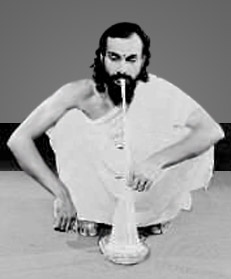Kriyas in Yoga are purifying processes, which help to free the human body from toxins and, thus, decontaminate the nervous system. In Sanskrit, the word Kriya means "action, deed, effort". These Kriyas are six in number according to traditional Yoga system. The Kriyas include Neti, Dhauti, Basti, Nauli, Shanka-prakshalan, Kapalbhati and Tarataka. For purification process, a student of Yoga can safely practice any of these methods.
Most people usually clean themselves externally to look best, but Yoga believes in external as well as internal cleaning, as the body, mind and soul are reliant on each other. Six fold purposes of Yoga Hygiene or kriyas include removal of diseases, purification of the external and the internal organs of the body; maintenance of highest physical efficiency; through good health; auto-immunization; longevity; mental, moral, and spiritual sublimation. Kriya usually refers to a technique or practice within a yoga discipline and also the outward physical manifestations of awakened kundalini. They are the impulsive movements resulting from the awakening of Kundalini energy. Types of kriya may widely vary between different schools of yoga.
It cannot be forgotten that the Kriya practices are a part of traditional Hatha Yoga. Certain kriyas eventually developed into the asanas of Hatha yoga and are mentioned as pre-requisites. It is believed that these practices cleanse the body and prepare it for the various postures of Hatha Yoga. The concept is often explained by giving the common example of cleaning up the house first before redecorating it. Cleanliness comes first and hence the importance of kriyas.
 Kriya Shakti is "a power of thought" and has been greatly studied by yogis since ages. Among the specific Kriya practices, Kriya Yoga has found profound interest amongst the yogis. The yogic kriyas or cleansing practices are also called shat-karma (six-actions). The practices of Kriya are quite difficult, sometimes revolting, strange and are not as easy as most yoga postures are. The Yoga gurus usually practice Kriyas and the students seldom perform these during the initial stage. Teaching these practices also requires great knowledge, since there is the risk of harming the student if something goes wrong. A person can hurt himself by practicing improper Kriya.
Kriya Shakti is "a power of thought" and has been greatly studied by yogis since ages. Among the specific Kriya practices, Kriya Yoga has found profound interest amongst the yogis. The yogic kriyas or cleansing practices are also called shat-karma (six-actions). The practices of Kriya are quite difficult, sometimes revolting, strange and are not as easy as most yoga postures are. The Yoga gurus usually practice Kriyas and the students seldom perform these during the initial stage. Teaching these practices also requires great knowledge, since there is the risk of harming the student if something goes wrong. A person can hurt himself by practicing improper Kriya.
The Yogic Kriyas are explained as follows -
•Dhauti is the first and most difficult kriya. It involves swallowing and re-gurgitating a fine piece of muslin cloth. It is prescribed only in case of serious ailments of the stomach like cancer. Dhauti Kriya is aimed at cleaning the mouth, throat and stomach.
•Basti is the ancient adaptation of enemas or colonic irrigation as it is now euphemistically called. It involves drawing water into the lower intestine through the anus and then expelling it. This aims to cleanse the lower part of the colon upto the sphincter.
•Neti is the practice where one involves cleaning up the nasal passages as well as the throat. It can be done with water pot (jala-neti), where water is poured into one nostril and it automatically comes out through the other. This method is a variation of Sutra-neti, where a fine thread is taken inside one nostril and then pulled out of the mouth through the throat. Other kinds of netis are also done with milk (dugdha-neti) or ghee (ghritha-neti). Neti is a precondition for cleaning up the respiratory passages for the proper practice of Pranayama.

•Tratak kriya is for cleansing and strengthening the eyes. The eyes are focused usually on a small object or the flame of the lamp in a dark room, without blinking, until they start watering. Advanced variations involve gazing firmly at a portrait of God or even imagining it in the mind`s eye.
•In case of Nauli Kriya, the rectus-abdominii (abdominal column) is churned left and right. Nauli is also considered as a vital Yoga asana that cures abdominal problems and other ailments.
•Shanka-prakshalan is another advanced kriya that cleans out the entire digestive tract. It involves drinking glass after glass of lukewarm salt water and then doing four particular exercises. Then the Yogi has to drink one more glass of the water and then do the exercises again. This is repeated until the person feels the urge to go to the toilet. After relieving, the Yogi must go back to the water drinking and exercises until once more the Yogi reaches for the toilet. One should notice the consistency of the faeces. This cycle of water drinking and exercises is to be repeated until the water expelled from the anus is as clear as the water the Yogi is drinking. At this stage, the person`s entire gastro-intestinal tract has been fully cleaned.
•Kapalbhati is also a kind of Kriya that cleanses the respiratory system, especially the lungs. This process involves forceful breathing in and out repeatedly. The lungs work like the bellows of a blacksmith. The body is kept in different positions for diverse effects.
After the practice of Kriyas, the individual usually gets extremely stressed out. The following day, the Yogi should consume a special diet, where he/she should only have "khichdi" consisting of boiled rice, lentils (dal) and ghee. This lubricating food replaces the natural lubrication of the internal organs, which has been washed out by the saline solution. Kriyas should be learned under the personal supervision of an expert teacher and practiced only after mastering the process.




















